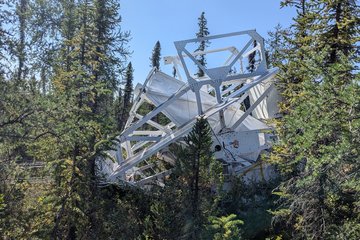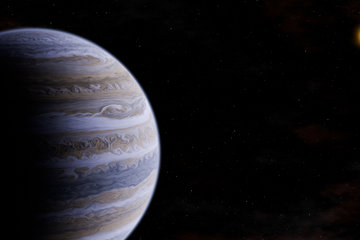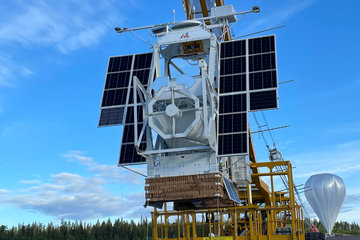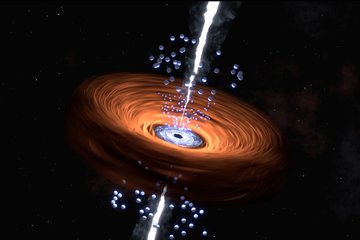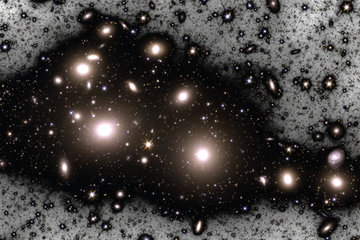Expedition to primeval matter
The researchers are hoping that the landing on the comet’s nucleus will provide them with unique insights into the early history of the planetary system
In the coming autumn, the Philae probe is expected land on the nucleus of the 67/P Churyumov-Gerasimenko comet, which is a mere four kilometres in diameter. Scientists from the Max Planck Institute for Solar System Research want to analyse the primeval building materials of the planets on site for the first time.
Text: Thorsten Dambeck

The list of celestial bodies that have already welcomed messengers from Earth is short. Our Moon is at the top as the place of the first manned landing. Then come Venus and Mars. And Europeans shouldn’t forget Saturn’s moon Titan, on whose exotic surface an ESA probe landed some time ago. Finally, there are the two planetoids Eros and Itokawa. That’s it.
If everything goes according to plan this November, however, European space travel could again make history: the European Rosetta mission includes the landing on the nucleus of a comet. Scientists from the Max Planck Institute for Solar System Research in Katlenburg-Lindau are playing a decisive role in the distant on-site inspection.
Philae, the lander, weighs around 100 kilogrammes and is the spacecraft intended to successfully perform this daring feat on 67/P Churyumov-Gerasimenko. “We’ll not only be exploring the comet for several months from an orbit, we want ground truth,” says Hermann Böhnhardt. Used here, ground truth means, in specialist terms: The observations of the Rosetta orbiter as it flies by are to be confirmed by measurements on the surface. Max Planck researcher Böhnhardt is Rosetta’s project scientist for the Philae lander.
The combination of these two probes makes it possible to carry out unique experiments, such as CONSERT (COmet Nucleus Sounding Experiment by Radiowave Transmission). Its methodology is similar to a tomography examination, although the patient in this case is a comet’s nucleus. And this is how it’s done: Rosetta emits radio waves, which penetrate the comet nucleus and reach Philae on the other side of the nucleus. Philae immediately returns the radio waves with its aerial.
What is the aim of this radio wave ping-pong? As it travels through the celestial body, the signal changes and thus enables conclusions to be drawn about the interior. “The inner structure of a comet is still largely unknown,” explains Böhnhardt. “We want to know for example whether it is more a loose accumulation of snow or mainly solid components.”
An important aspect is whether there are larger voids or layers on the nucleus. “Better data on the structure of the comet will help us to understand the exact formation process of the large bodies in the solar system, the planets,” explains Hermann Böhnhardt. These accrete from smaller bodies in a multi-stage process according to the topical theories.
Comets are considered to be relics of this early phase of planet formation. The question of whether comet nuclei themselves are composed from even smaller bodies is one which is keeping the researchers busy at the moment. A non-destructive look into the inside of such a rock has never been tried before; with CONSERT, the planet researchers are entering new scientific territory.
Other experiments by Philae aim to measure the temperature in the ground, and are planned to depths of a few metres; in this way, the researchers want to decipher the heat flux inside the nucleus. An automatic hammer will drive the sensors into the ground; such measurements are impossible from the orbit. A landing is also a must for COSAC (Cometary Sampling and Composition Experiment), which Philae wants to use to complete the detailed chemical analyses on its to-do list.

“COSAC is Philae’s nose,” says the head scientist responsible for the instrument, Fred Goesmann, from the Max Planck Institute for Solar System Research. In somewhat more technical terms: “The experiment uses a gas chromatograph and a time-of-flight mass spectrometer.” The former feeds a gas mixture through very thin capillary tubes several metres long and separated from each other. The second instrument analyses ions by means of their time of flight in an electric field.
COSAC was developed and built at the Max Planck Institute in cooperation with scientists from Paris and Giessen; its weighs a total of 4.5 kilogrammes.
The objective of this experiment is to analyse the volatile substances of the comet. The original material is probably hidden under the surface of its nucleus; Philae’s drill will therefore take the samples from a depth of a few decimetres. As soon as the material is brought into the onboard ovens, the gradual heat treatment begins. The gases produced here are fed to the gas chromatograph, the spectrometer or even to both analytical units.
“Similar investigations were conducted as part of the Viking mission and currently during the Curiosity mission on Mars,” says Goesmann. On the comet, the researchers will use this method to look for the chemical precursors of life. “We are interested in organic, meaning carbonaceous, molecules.” This is because the ancient comets could be significant for the origin of life, according to Goesmann.
“All life on Earth is based on the hereditary molecules DNA and RNA and other complex molecules, the proteins,” explains the physicist. “When our Earth formed, it was much too hot in the beginning, and these organic molecules were quickly destroyed by the temperatures at that time.”
Astrobiologists therefore assume that at least some of the basic materials which are important for the chemical evolution reached the cooled down Earth at a later time with impacts of comets and asteroids. An exciting question concerns the chirality - the handedness - of the organic compounds: If COSAC really discovers complex organic molecules, this poses the question whether these already show a tendency towards left handedness, as is exhibited by all terrestrial amino acids?
Every time they orbit the Sun, comets emit gases, which in turn entrain dust particles. How long can this go on? When do the magnificent tails disappear? Measurements that are intended to provide answers to this are planned with the Dust Impact Monitor (DIM). This device originates from the Budapest Centre for Energy Research and is operated jointly by the Max Planck Institute for Solar System Research and the German Aerospace Center (DLR) in Cologne.

“We want to use DIM to measure the number and the size of the impacting dust particles, their approximate directional distribution and the time dependence of these measured quantities,” says head scientist Harald Krüger from the Max Planck Institute about the cube-shaped instrument. It is responsible for comparably large particles measuring around one millimetre in diameter; significantly smaller particles are detected by the COSIMA experiment on the Rosetta orbiter. Whether such cometary particles succeed in leaving the nucleus depends on their speed. “The escape velocity from the comet’s surface is around one metre per second. If the particles are slower, they fall back,” says Krüger.
For the measurements to become reality, the landing first has to succeed. This manoeuvre cannot be imagined like a landing on a large planet, says Harald Krüger, because at four kilometres, the nucleus of the destination comet is only as big as a small town. Its gravity is just below one millionth of the terrestrial value.
If Philae is to land as slowly as a pedestrian, its kinetic energy must be damped when it is on the ground. The danger otherwise is that it will bounce back up again like a rubber ball. The damping and the secure anchorage in the ground are crucial for a successful landing - the technical components for this also originate from the Max Planck workshops, incidentally.








